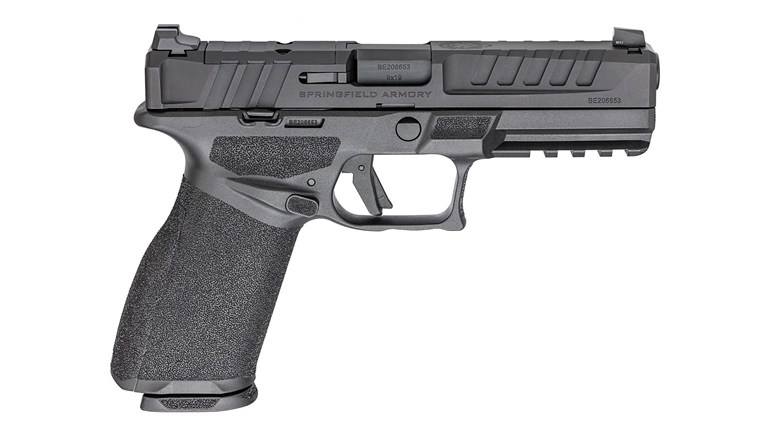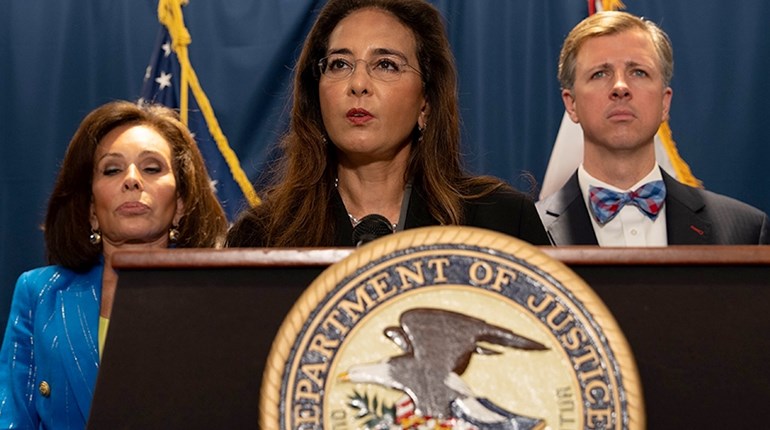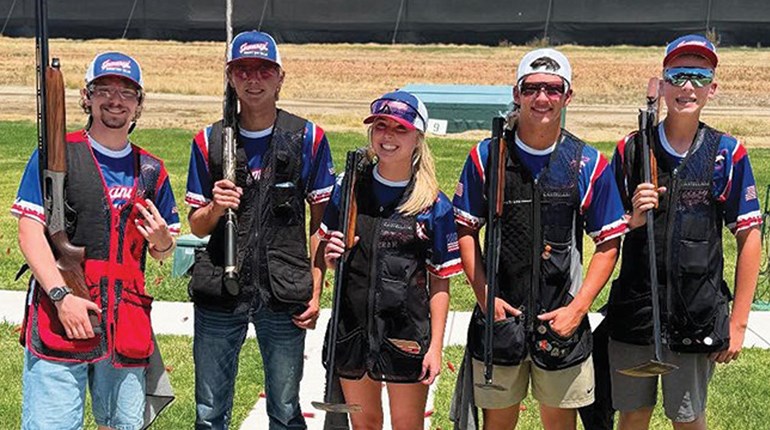
When Gianni Giordano shot his first rifle at age three, he couldn’t have known that by age 15 he’d be a Grand Master in the Limited division of the United States Practical Shooting Association (USPSA). Now 19 years old, he also had no way of knowing that the Biden administration and officials in some of America’s most-populous states would move to take away his Second Amendment rights, at least until his 21st birthday.
Giordano just wanted to shoot. And shoot he has. He has claimed the USPSA National Limited Junior Champion title six times. Outside of shooting, Gianni helps manage his family’s farm and is both a machinist and an entrepreneur.
Clearly, Gianni has proven himself to be a responsible, motivated and capable young man who is more skilled with a handgun than most people, yet he is currently unable to buy one from a licensed dealer even though he is a legal adult; in fact, until he turned 18, it was illegal for him to even possess the handgun and ammunition he used in competitions without his parents’ explicit permission.
“Some people don’t understand that shooting is a sport,” said Gianni. There are many different disciplines, several of which are conducted at the Olympic and college levels. “Being a sponsored competitive shooter has allowed me to educate many,” he said. “The responsibility that comes with this is huge. When people see me, at my age, having this responsibility and handling firearms with respect, it opens their eyes. It is possible, with education and familiarity, for people to be safe. We prove it daily when we compete.”
Youth sports start before elementary school—and no one stops a 12 year old with an allowance from using a basketball or soccer ball. This gives them access to the tools they need to train and succeed from a very young age.
In most states, you must be 21 to purchase a handgun. And some states are pushing for 21 to be the minimum age for all firearms sales.
As with other sports, to be competitive at a college level or higher, you must start training in the shooting sports much earlier than 21. Many college teams have identified specific competitive shooters before they even start high school.
National service rifle champion Kris Friend is a member of the U.S. Army Reserve rifle team but got his start as a member of the Connecticut Junior Rifle Team. “The Connecticut junior team I was a part of from 2001 to 2006 was full of kids who went on to bigger and better things, in part from the discipline and direction the junior team provided,” said Friend, “including multiple service-team competitors, Whistler Boy national champions, four President’s Rifle Trophies, a Mountain Man Trophy winner and numerous national records. Some went on to commission and serve their country and ultimately leave the competitive-shooting world, but their exposure to the military teams at Camp Perry influenced them greatly. The shooters developed through the program, even though there was not a range over 200 yards inside the state. There are still three, including myself, from that era who compete for service teams at a high level.”
Sadly, the program that did so much for so many no longer exists. “The laws created after the tragedy in Newtown made it nearly impossible if not outright illegal for young shooters to be exposed to service-rifle competitions. I don’t know that there is any hope to bring a service-rifle team back from extinction. All that remains is a weakening smallbore community that has also been diminished due to the laws enacted in the state as well as the anti-gun culture that has flourished in the state ever since,” said Kris.

Even where similar programs remain, it still takes an adult to physically get a youth to the range. School-sanctioned sports generally have school transportation, but shooting sports are not afforded this luxury. Backyard practice is also not an option for most shooters. To practice shooting, you need the ability to get to a range and access the property. Individual state laws regarding firearm possession and transportation complicate this.
National champion and sponsored shooter Jalise Williams has been competing since she was 10 years old. Now, at 20, she can vote, buy long guns, drive and travel unaccompanied, but she still cannot legally own the handguns she uses to practice and to win matches in USPSA, IPSC, IDPA and 3-Gun. Living in Utah, which is more Second Amendment-friendly than some other states, she has been able to do a bit more than some under-21 competitors.
“When I got my driver’s license in Utah, I had to fill out paperwork and keep it on me at all times when I was driving with guns so that they would be ‘legally’ in my possession,” she said. “To this day, I have to have it because I specialize in handguns and since I am under 21, I can only legally drive with my handguns to and from the range. This also makes flying and traveling with guns difficult and I have to rely on others to travel with me.” In other words, a competitor with 18 national titles and international placements must plan her events around when others can be present just because of her age.
It’s all particularly ironic in a society that claims to be obsessed with diversity, inclusion and equity. Shooting sports are far more inclusive than most other sports—whatever gender, race, age, height or weight you might be, and whatever physical abilities you might have, you can learn to shoot and perform well.
When competitive shooter and Second Amendment advocate Beth Walker was looking for a non-contact sport after two severe concussions in middle school, she selected shooting. And it wasn’t just because of the injury, though that limited her choices.
Given the clearly positive culture in youth shooting sports, the only logical explanation for vilifying them is political.
“I definitely could have chosen tennis or badminton,” said Walker, “but watching the community of people involved in competitive shooting and the responsibility and maturity displayed by the youth involved, it was a clear choice. I couldn’t play tennis and get the chance to play with Serena Williams, but I could shoot 3-Gun and shoot with the greats like Jerry Miculek, the Yackleys, Dianna Muller, Keith Garcia and the Army Marksmanship Unit. And those are the best of the best that are beside you, teaching and guiding. The community side of shooting is unmatched. The environment that fostered my growth and maturity was an absolutely pivotal factor in my choice.”
The burdens continue to pile on for these young shooters. The recent decision of the Biden administration to refuse to give funding to schools for youth shooting and archery programs—a stunning strike at these young athletes executed via the NRA-opposed Bipartisan Safer Communities Act (BSCA)—created a critical funding crisis that, unfortunately, is just an example of an overall cultural-war attack on this right.
The NRA Foundation has long sought to compensate for funding shortages in youth shooting programs—by, for example, contributing more than $7 million to youth shooting sports in 2022, including to both public and private schools for shotgun programs, National Archery in the Schools (NASP), Junior Reserve Officer Training Corps (JROTC), 4-H, Future Farmers of America (FFA), state hunter’s education programs, air rifle teams and marksmanship programs—to close existing financial gaps, but these funds have not covered everything that is needed.
Between the never-ending legal and financial hurdles, financially disadvantaged families suffer the most. Junior programs have traditionally provided loaner rifles and ammunition at a reduced cost or no cost to young competitors. They have also provided gear to allow youth to learn marksmanship and firearm safety without a significant financial barrier to entry. Costs add up fast, and many families can’t afford them. Also, it’s hard to keep up as the applicable laws seem to continually change.
And, while school and college sports teams are often well-funded, and professional athletes in basketball, football and other sports are paid millions of dollars, the top athletes in shooting sports, regardless of age, rarely receive anything more than a small prize or refund on match fees. Top performers can’t even count on positive media attention. If a 15-year-old kid were to beat LeBron James in basketball, it would be all over the news. Young shooters often top podiums in shooting sports, but are rarely given recognition.
With the support of their family, Jalise and her sister, Justine, have become professional athletes at very young ages, but it certainly isn’t easy. Jalise explained it is hard to balance the time and expense needed to perform at the highest level with a typical 9-to-5 job.
“Shooting is a sport, yet the world does not treat it like one. There are many of us who dedicate our lives to shooting sports, yet we cannot make a full living at it,” said Jalise. “Ten years later, after 18 national titles, records placed and representing Team USA in international competitions, I am still struggling. If this were any other sport, I would be set for life. But because this is the firearms industry and the world believes that firearms are ‘bad,’ there is no funding. The firearms community largely finances itself without outside influence. This makes it harder to make a living being an athlete because there isn’t enough money to go around.”

Without professional shooters achieving the same recognition as other athletes, it becomes even harder for the world to understand why young Americans need access to firearms.
The Yackleys are a sponsored family of competitive shooters, hunters and advocates for the industry. They compete in 3-Gun, USPSA, IPSC, Bianchi/NRA Action Pistol and PRS. Becky Yackley explained that she and her husband grew up competitively and decided to return as their three boys grew older. “We grew exhausted with swim team and wrestling meets, and not being with our children while they competed. So, in 2011, we went back to shooting,” she said. “Since then, it’s been a busy ride of traveling the country and the world competing. Shooting sports are not just an event or hobby for us—it’s work and life.”
Perhaps negative views about “kids with guns” could be dispelled if more people could know about families like the Yackleys.
Becky said one of the biggest challenges of raising young people in the shooting sports is “teaching them to be both open and share their love for the sport, but also cautious of the judgment and potential prejudices they will meet.”
“In regard to the attacks on the rights of the young people who would like to own firearms,” she said, “you have to really start to question the elephant in the room of mental health. We go from 1950-60’s ads for BB guns and rifles in places like the Sears catalog to banning youth from even seeing firearms. It’s like a book-burning—but no books. It’s an idea-burning. We see an alternate idea being fabricated and repeated that only crazy, fringe types want youth to use firearms.”
Popular-culture messaging makes any young person who likes guns appear to be “bad” or “evil.” Yet, youth shooting and archery programs have been significantly positive forces in society. As the Congressional Sportsmen’s Caucus, a bipartisan caucus of Capitol Hill lawmakers, noted in a letter protesting the use of the BSCA to defund school archery and shooting programs, “These programs are popular among teachers and school personnel … . Student participation has been correlated with improvements in academic performance, behavior and school attendance. In the case of school sponsored archery programs … there are more than 1.3 million students in nearly 9,000 schools across 49 states that participate each academic year.”
With all these benefits and the clearly positive culture in youth shooting sports, the only logical explanation for vilifying them is that it helps push an agenda.
“There’s a battle for the minds of young people,” said Becky Yackley. “It’s on families and parents, leaders and mentors, to ensure that the youth inform themselves, educate themselves and each other, and seize their future by throwing out the garbage that the ill-informed and manipulated minds have ushered in to hold them in shackles.”


































